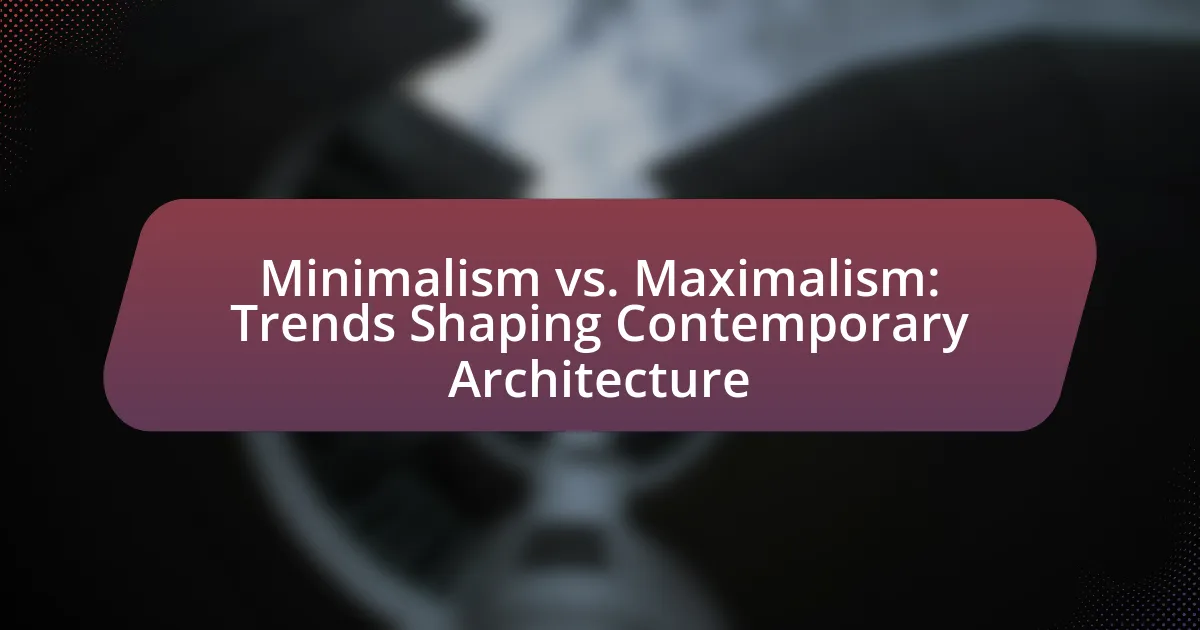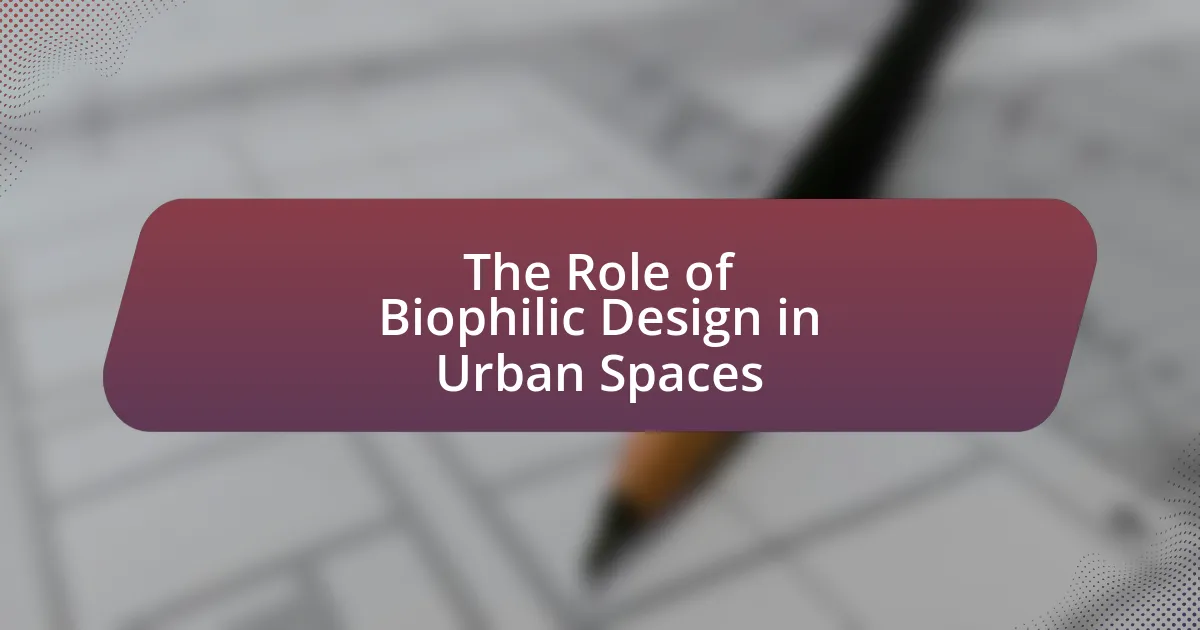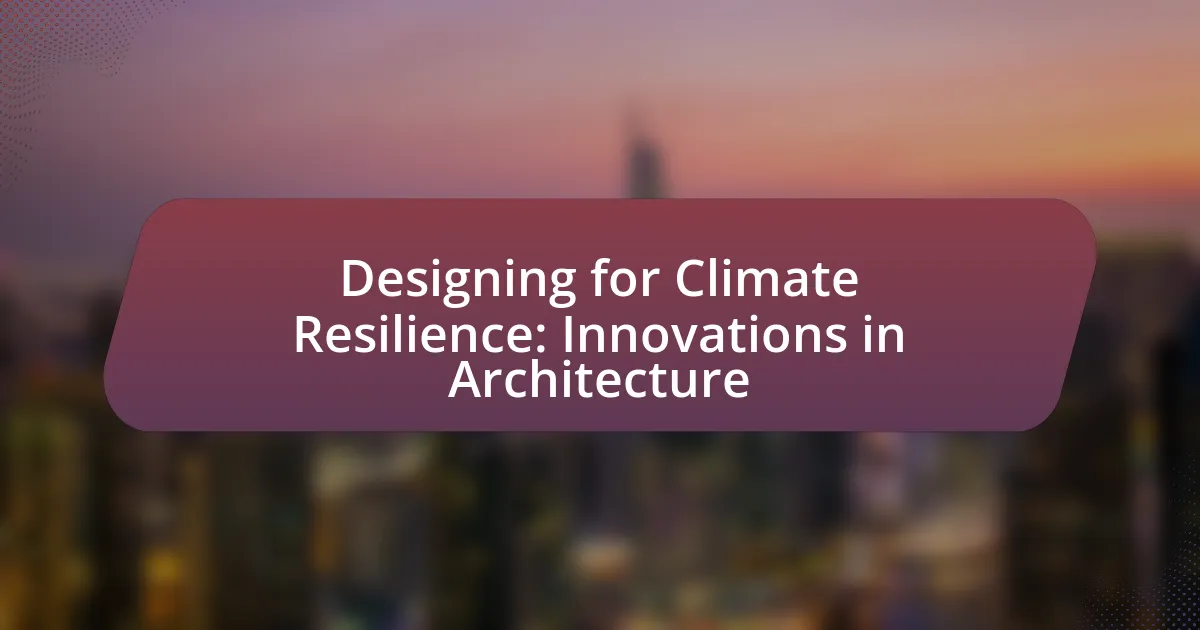Integrating smart technology into architectural design involves the incorporation of advanced digital systems and automation to enhance building functionality, efficiency, and user experience. Key technologies include smart lighting, climate control, security systems, and energy management, which collectively contribute to significant energy savings and improved occupant comfort. The article explores how these technologies enhance architectural design, the environmental benefits they provide, and the challenges faced during integration. It also discusses best practices for architects, including user-centered design principles and collaboration with technology experts, while highlighting future trends such as artificial intelligence and sustainable materials in smart architecture.

What is Integrating Smart Technology into Architectural Design?
Integrating smart technology into architectural design involves the incorporation of advanced digital systems and automation into building structures to enhance functionality, efficiency, and user experience. This integration includes features such as smart lighting, climate control, security systems, and energy management, which are designed to optimize resource use and improve occupant comfort. For instance, according to a report by the International Energy Agency, buildings equipped with smart technologies can reduce energy consumption by up to 30%, demonstrating the tangible benefits of such integration in modern architecture.
How does smart technology enhance architectural design?
Smart technology enhances architectural design by enabling greater efficiency, sustainability, and user experience through advanced data integration and automation. For instance, smart building systems utilize sensors and IoT devices to monitor energy usage, optimize lighting, and control HVAC systems, leading to reduced energy consumption by up to 30% according to the U.S. Department of Energy. Additionally, smart technology facilitates real-time data analysis, allowing architects to make informed design decisions that improve functionality and aesthetics. This integration of technology not only streamlines construction processes but also enhances the adaptability of spaces to meet evolving user needs.
What types of smart technologies are commonly used in architecture?
Commonly used smart technologies in architecture include Building Information Modeling (BIM), smart lighting systems, energy management systems, and IoT (Internet of Things) devices. Building Information Modeling enhances design accuracy and collaboration by allowing architects to create detailed 3D models that integrate various building systems. Smart lighting systems improve energy efficiency and user comfort by adjusting based on occupancy and natural light levels. Energy management systems monitor and optimize energy consumption, contributing to sustainability goals. IoT devices facilitate real-time data collection and automation, enabling smarter building operations. These technologies collectively enhance functionality, efficiency, and sustainability in architectural design.
How do these technologies improve building functionality?
Smart technologies enhance building functionality by optimizing energy efficiency, improving occupant comfort, and enabling real-time monitoring and control of building systems. For instance, smart HVAC systems adjust temperature and airflow based on occupancy and weather conditions, leading to energy savings of up to 30% according to the U.S. Department of Energy. Additionally, smart lighting systems can automatically adjust brightness based on natural light levels, further reducing energy consumption. These technologies also facilitate predictive maintenance through sensors that monitor equipment performance, thereby minimizing downtime and repair costs.
Why is integrating smart technology important in modern architecture?
Integrating smart technology is important in modern architecture because it enhances efficiency, sustainability, and user experience. Smart technology allows for the automation of building systems, such as lighting, heating, and security, which can lead to significant energy savings; for instance, buildings equipped with smart systems can reduce energy consumption by up to 30%. Additionally, smart technology facilitates real-time monitoring and data analysis, enabling architects and builders to optimize designs based on user behavior and environmental conditions. This integration not only improves the functionality of spaces but also contributes to the overall sustainability goals of modern architecture, aligning with global efforts to reduce carbon footprints and promote eco-friendly practices.
What are the environmental benefits of smart technology in buildings?
Smart technology in buildings significantly reduces energy consumption and enhances resource efficiency. By utilizing sensors and automation, smart systems optimize heating, cooling, and lighting based on occupancy and environmental conditions, leading to energy savings of up to 30% according to the U.S. Department of Energy. Additionally, smart technology facilitates better water management through real-time monitoring, which can decrease water usage by 20-50%, as reported by the Environmental Protection Agency. These advancements contribute to lower greenhouse gas emissions and promote sustainable practices in the built environment.
How does smart technology contribute to user experience in architectural spaces?
Smart technology enhances user experience in architectural spaces by providing personalized, efficient, and interactive environments. For instance, smart lighting systems adjust brightness and color based on user preferences and natural light availability, improving comfort and productivity. Additionally, smart climate control systems optimize temperature and air quality, which has been shown to increase occupant satisfaction and well-being. Furthermore, integrated smart systems facilitate seamless interaction through mobile applications, allowing users to control various aspects of their environment, such as security and entertainment, from a single interface. Research indicates that buildings equipped with smart technology can lead to a 20% increase in user satisfaction, demonstrating the significant impact of these innovations on the overall experience within architectural spaces.
What challenges are faced when integrating smart technology into architectural design?
Integrating smart technology into architectural design faces several challenges, including high costs, interoperability issues, and the need for specialized skills. High costs arise from the initial investment required for advanced technology and ongoing maintenance. Interoperability issues occur when different smart systems and devices do not communicate effectively, leading to inefficiencies. Additionally, the integration of smart technology requires architects and designers to possess specialized skills and knowledge, which may not be widely available in the current workforce. These challenges can hinder the seamless incorporation of smart technology into architectural projects.
What are the technical limitations of current smart technologies?
Current smart technologies face several technical limitations, including interoperability issues, data privacy concerns, and reliance on stable internet connectivity. Interoperability challenges arise when different smart devices and systems fail to communicate effectively, leading to fragmented user experiences. Data privacy concerns stem from the collection and storage of personal information, which can be vulnerable to breaches; for instance, a 2021 report by the Identity Theft Resource Center noted a 17% increase in data breaches compared to the previous year. Additionally, many smart technologies depend on consistent internet access, which can hinder functionality in areas with poor connectivity, limiting their usability in diverse environments.
How do cost considerations impact the integration of smart technology?
Cost considerations significantly influence the integration of smart technology by determining the feasibility and scope of implementation. Budget constraints often dictate the selection of specific technologies, as higher initial investments may limit the adoption of advanced systems. For instance, a study by McKinsey & Company indicates that companies that prioritize cost-effective smart technology solutions can achieve a return on investment of up to 30% within the first three years. Additionally, ongoing operational costs, including maintenance and energy consumption, further impact decision-making, as stakeholders seek to balance upfront expenses with long-term savings. Therefore, careful financial planning is essential to ensure that smart technology integration aligns with both immediate budgetary limits and future operational efficiencies.
How can architects effectively incorporate smart technology into their designs?
Architects can effectively incorporate smart technology into their designs by integrating Internet of Things (IoT) devices, automated systems, and energy-efficient solutions. This integration allows for enhanced building management, improved energy efficiency, and increased occupant comfort. For instance, smart lighting systems can adjust based on occupancy and natural light levels, reducing energy consumption by up to 30% according to the U.S. Department of Energy. Additionally, architects can utilize building information modeling (BIM) to simulate and optimize the performance of smart technologies during the design phase, ensuring seamless integration and functionality.
What design principles should be followed for successful integration?
Successful integration of smart technology into architectural design requires adherence to principles such as user-centered design, interoperability, scalability, and sustainability. User-centered design ensures that technology enhances the user experience by prioritizing the needs and preferences of occupants. Interoperability allows different systems and devices to communicate effectively, facilitating seamless integration. Scalability ensures that the technology can grow and adapt with changing needs, while sustainability focuses on minimizing environmental impact and promoting energy efficiency. These principles are supported by industry standards and best practices, such as the International Organization for Standardization (ISO) guidelines, which emphasize the importance of these factors in achieving effective integration.
How can collaboration with technology experts enhance architectural projects?
Collaboration with technology experts enhances architectural projects by integrating advanced tools and methodologies that improve design efficiency and functionality. Technology experts bring specialized knowledge in areas such as Building Information Modeling (BIM), smart building systems, and sustainable technologies, which can lead to innovative design solutions. For instance, the use of BIM allows architects to visualize and simulate building performance, reducing errors and optimizing resource use. A study by McGraw Hill Construction found that 70% of firms using BIM reported improved project outcomes, demonstrating the tangible benefits of such collaboration.
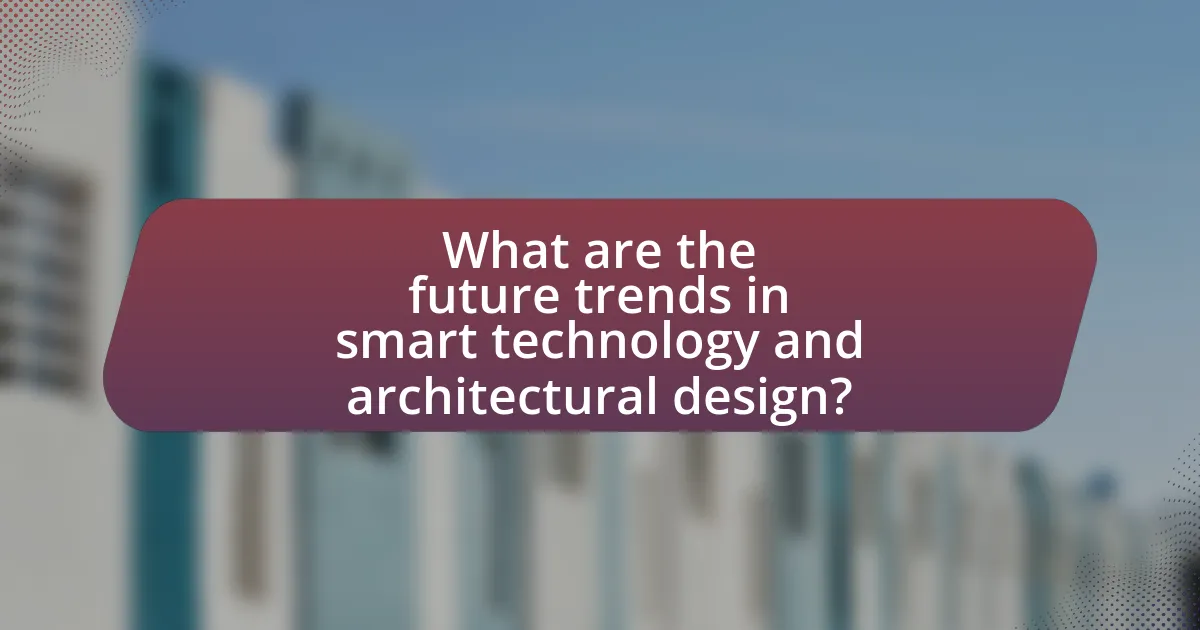
What are the future trends in smart technology and architectural design?
Future trends in smart technology and architectural design include the integration of artificial intelligence, sustainable materials, and IoT connectivity. Artificial intelligence is increasingly being utilized for predictive analytics in building management, optimizing energy use and enhancing occupant comfort. Sustainable materials, such as recycled and bio-based products, are gaining traction as architects aim to reduce environmental impact and improve building efficiency. Additionally, the Internet of Things (IoT) is facilitating real-time data collection and automation, allowing for smarter building systems that adapt to user needs and environmental conditions. These trends are supported by the growing demand for energy-efficient buildings, as evidenced by the global green building market, which is projected to reach $1.64 trillion by 2027, highlighting the shift towards smarter, more sustainable architectural practices.
How is the role of artificial intelligence evolving in architecture?
The role of artificial intelligence in architecture is evolving through enhanced design processes, predictive analytics, and automation. AI technologies are increasingly utilized for generating design options, optimizing building performance, and improving project management efficiency. For instance, AI algorithms can analyze vast datasets to inform design decisions, leading to more sustainable and cost-effective solutions. A study by the American Institute of Architects highlights that AI can reduce design time by up to 30% while increasing accuracy in project outcomes. This integration of AI not only streamlines workflows but also fosters innovation in architectural practices.
What potential does AI hold for optimizing building performance?
AI has significant potential for optimizing building performance by enhancing energy efficiency, improving occupant comfort, and streamlining maintenance processes. For instance, AI algorithms can analyze real-time data from building management systems to optimize heating, ventilation, and air conditioning (HVAC) settings, leading to energy savings of up to 30% as reported by the U.S. Department of Energy. Additionally, AI can predict maintenance needs through predictive analytics, reducing downtime and repair costs. This integration of AI in building performance management not only promotes sustainability but also enhances the overall user experience within the built environment.
How can AI-driven design tools change the architectural workflow?
AI-driven design tools can significantly enhance the architectural workflow by automating repetitive tasks and providing data-driven insights. These tools streamline processes such as drafting, modeling, and analysis, allowing architects to focus on creative and strategic aspects of design. For instance, generative design algorithms can produce multiple design alternatives based on specified parameters, which can lead to innovative solutions that may not have been considered otherwise. Additionally, AI can analyze vast amounts of data related to site conditions, building materials, and energy efficiency, enabling architects to make informed decisions that optimize performance and sustainability. Studies have shown that firms utilizing AI in their design processes report increased efficiency and reduced project timelines, demonstrating the transformative impact of these technologies on architectural workflows.
What innovations are on the horizon for smart building technologies?
Innovations on the horizon for smart building technologies include advanced artificial intelligence systems, enhanced energy management solutions, and improved building automation systems. These innovations aim to optimize energy efficiency, enhance occupant comfort, and streamline facility management. For instance, AI-driven predictive analytics can analyze data from various building systems to anticipate maintenance needs and optimize energy consumption, potentially reducing operational costs by up to 30%. Additionally, the integration of Internet of Things (IoT) devices allows for real-time monitoring and control of building systems, leading to more responsive and adaptive environments. These advancements are supported by ongoing research and development in smart technology, indicating a significant shift towards more sustainable and intelligent building practices.
What emerging technologies are expected to influence architectural design?
Emerging technologies expected to influence architectural design include Building Information Modeling (BIM), augmented reality (AR), virtual reality (VR), and sustainable materials. BIM enhances collaboration and efficiency by allowing architects to create detailed 3D models that integrate various aspects of a building’s lifecycle. AR and VR provide immersive experiences for clients and stakeholders, enabling them to visualize designs before construction begins. Sustainable materials, such as self-healing concrete and recycled composites, are increasingly being adopted to reduce environmental impact and improve energy efficiency in buildings. These technologies collectively drive innovation and sustainability in architectural practices.
How might sustainability practices shape future smart architecture?
Sustainability practices will significantly shape future smart architecture by prioritizing energy efficiency, resource conservation, and environmental impact reduction. These practices will drive the integration of renewable energy sources, such as solar panels and wind turbines, into building designs, enhancing energy autonomy and reducing reliance on fossil fuels. For instance, the World Green Building Council reports that green buildings can reduce energy consumption by up to 50% compared to conventional structures. Additionally, smart architecture will incorporate advanced materials and technologies, such as energy-efficient insulation and smart sensors, to optimize energy use and minimize waste. This shift towards sustainability not only meets regulatory requirements but also aligns with growing consumer demand for environmentally responsible living spaces.
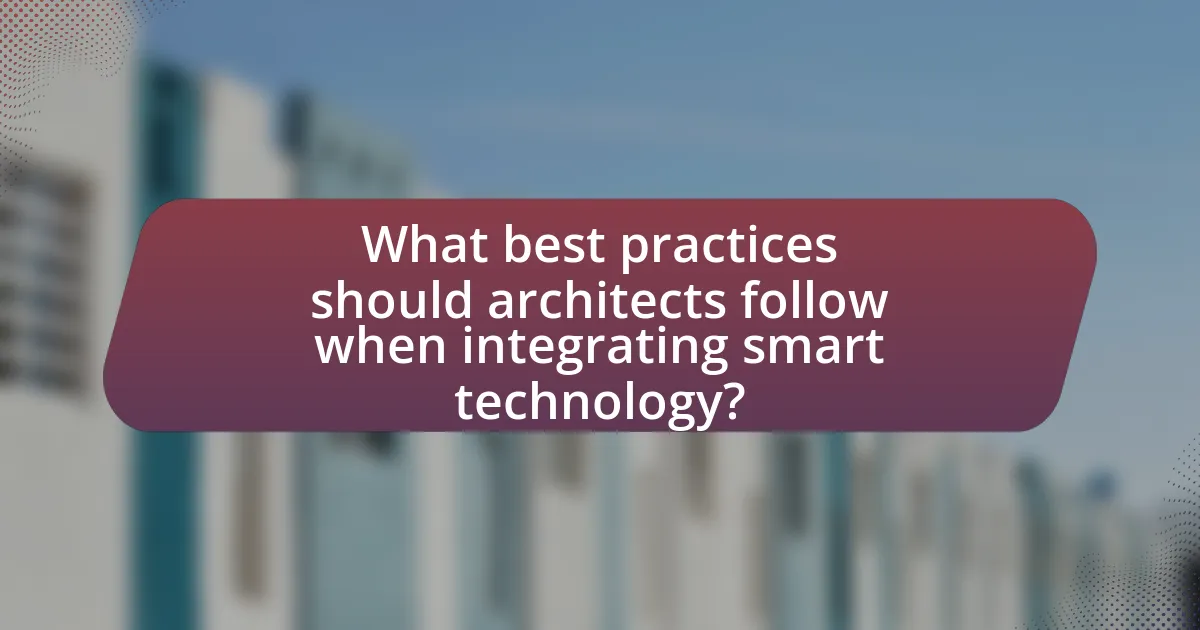
What best practices should architects follow when integrating smart technology?
Architects should prioritize user-centered design when integrating smart technology. This involves understanding the needs and behaviors of the end-users to create intuitive and functional spaces. For instance, incorporating user feedback during the design process can lead to more effective technology integration, as evidenced by studies showing that spaces designed with user input result in higher satisfaction rates. Additionally, architects should ensure interoperability among devices to create a seamless experience; research indicates that systems that communicate effectively reduce user frustration and enhance overall functionality. Lastly, architects must consider sustainability by selecting energy-efficient technologies, as buildings equipped with smart systems can reduce energy consumption by up to 30%, according to the U.S. Department of Energy.
How can architects ensure user-centered design in smart buildings?
Architects can ensure user-centered design in smart buildings by actively involving users in the design process through methods such as surveys, focus groups, and participatory design workshops. This approach allows architects to gather direct feedback on user needs and preferences, which can be integrated into the building’s design features, such as layout, lighting, and technology interfaces. Research indicates that user involvement leads to higher satisfaction and better usability in smart environments, as evidenced by a study published in the Journal of Building Performance, which found that buildings designed with user input had a 30% increase in occupant satisfaction compared to those that did not incorporate user feedback.
What methods can be used to gather user feedback during the design process?
Surveys and interviews are effective methods to gather user feedback during the design process. Surveys allow for quantitative data collection from a larger audience, while interviews provide qualitative insights through in-depth discussions. According to a study by the Nielsen Norman Group, user interviews can reveal specific user needs and preferences that surveys may not capture, making them invaluable for understanding user experiences. Additionally, usability testing can be employed to observe users interacting with prototypes, providing direct feedback on functionality and design. This combination of methods ensures a comprehensive understanding of user perspectives, which is crucial for integrating smart technology into architectural design.
How can architects balance aesthetics with technology in their designs?
Architects can balance aesthetics with technology by integrating smart technology seamlessly into their designs without compromising visual appeal. This can be achieved through the use of innovative materials and design techniques that enhance both functionality and beauty. For instance, the incorporation of smart glass can provide energy efficiency while maintaining an elegant facade. Research from the American Institute of Architects indicates that buildings designed with integrated technology can improve user experience and sustainability, demonstrating that aesthetic and technological elements can coexist harmoniously.
What are common pitfalls to avoid in smart technology integration?
Common pitfalls to avoid in smart technology integration include inadequate planning, lack of user training, and failure to ensure interoperability among devices. Inadequate planning often leads to misalignment between technology capabilities and project goals, resulting in wasted resources and ineffective solutions. Lack of user training can hinder the adoption of smart technologies, as users may struggle to utilize the systems effectively, leading to frustration and underutilization. Additionally, failure to ensure interoperability can create silos where devices from different manufacturers do not communicate, limiting the overall functionality and efficiency of the integrated system. These pitfalls can significantly undermine the intended benefits of smart technology in architectural design.
How can architects prevent overcomplicating designs with technology?
Architects can prevent overcomplicating designs with technology by prioritizing simplicity and functionality in their design processes. By focusing on user experience and the core purpose of the space, architects can ensure that technology enhances rather than complicates the design. For instance, employing user-centered design principles allows architects to identify essential technological features that meet the needs of occupants without unnecessary complexity. Research indicates that designs incorporating intuitive technology lead to higher user satisfaction and usability, as seen in studies conducted by the American Institute of Architects, which emphasize the importance of balancing innovation with practicality in architectural design.
What strategies can be employed to ensure technology remains user-friendly?
To ensure technology remains user-friendly, designers should prioritize user-centered design principles. This involves conducting user research to understand the needs and preferences of the target audience, which can lead to intuitive interfaces and functionalities. For instance, usability testing can reveal how real users interact with technology, allowing for iterative improvements based on feedback. Additionally, employing consistent design patterns and clear navigation aids in reducing cognitive load, making technology easier to use. Research by Nielsen Norman Group indicates that usability testing can improve user satisfaction by up to 80%, demonstrating the effectiveness of these strategies in creating user-friendly technology.
What practical tips can architects implement for successful integration?
Architects can implement several practical tips for successful integration of smart technology into architectural design. First, they should prioritize early collaboration with technology experts to ensure that the design accommodates the necessary infrastructure for smart systems. This collaboration can lead to a more seamless integration process, as highlighted by the American Institute of Architects, which emphasizes the importance of interdisciplinary teamwork in modern design projects.
Second, architects should conduct thorough research on the latest smart technologies and their applications in building design, which can enhance energy efficiency and user experience. For instance, integrating IoT devices can optimize building management systems, as evidenced by studies showing that smart buildings can reduce energy consumption by up to 30%.
Third, architects must consider user experience by designing intuitive interfaces for smart systems, ensuring that occupants can easily interact with technology. This focus on usability can significantly improve the overall effectiveness of smart integrations, as noted in user experience research that indicates well-designed interfaces lead to higher user satisfaction and engagement.
Finally, architects should remain adaptable and open to feedback during the integration process, allowing for adjustments based on real-world performance and user input. This iterative approach can lead to more successful outcomes, as demonstrated by case studies of smart buildings that have evolved through user feedback and technological advancements.



